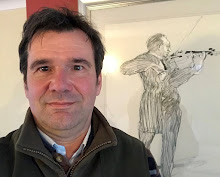Monday, 30 November 2009
ClimateGate
Is the Landscape Institute building a core element of the Landscape Architecture profession on the back of possibly bad science? Should the LI push ahead with its response to "global warming" or wait and see what independent review of the raw data discovers? Or do Landscape Architects simply say that much of the LI response makes sense irrespective of global temperature, e.g. as a response to possible oil shortages and/or price increases.
Monday, 2 November 2009
Living willow walls
I first saw living woven willow fences in "Radical Landscapes" by Jane Amidon. She highlighted the show garden at Chaumont-sur-Loire 1996 of Judy and David Drew called "Saules dans la Brume" ("Willows in the fog")
I love the fact that the willows are alive and growing. I love the craftsmanship and artistry in the woven pattern. I like the fact that it is of a bulky material yet appears light and almost transparent. This is a quality I notice in much Gothic work, like the Oxford University museum.
These living fences - or "fedges" - would certainly be suitable as the walls of a green meeting place in the forest. There are certainly many experts out there who know how to do this:
http://www.willowpooldesigns.co.uk/gallery.cfm?iCategoryIDPK=12
http://www.westwaleswillows.co.uk/fedgeplanting.html
The woven willows form a trellis that supports new leaf growth. "The display thickens as the sun and a microclimate of mist provide nourishment."
I love the fact that the willows are alive and growing. I love the craftsmanship and artistry in the woven pattern. I like the fact that it is of a bulky material yet appears light and almost transparent. This is a quality I notice in much Gothic work, like the Oxford University museum.
These living fences - or "fedges" - would certainly be suitable as the walls of a green meeting place in the forest. There are certainly many experts out there who know how to do this:
http://www.willowpooldesigns.co.uk/gallery.cfm?iCategoryIDPK=12
http://www.westwaleswillows.co.uk/fedgeplanting.html
Sunday, 1 November 2009
Symbolism of stained glass windows
Gothic as a style has been hi-jacked many times (not least by the horror literature, vampires and "goths").
"Only a minority of modern designers have followed Ruskin's ideal of anonymous craftsmen working in harmony for the benefit of art and society" "Some modern co-operations use Gothic as a branding device. However, wheareas the monastic buildings represented and promoted specific morals, the modern counterpart has no specific meaning." (Buchanan)
"East window of the quire at Gloucester Cathedral is the largest window in Europe.
The medieval stained glass shows the powerful on earth surmounted by the heavenly hierarchy"
"At Coventry, a mdern cathedral replaced its bombed medieval predecessor. John Piper's stained glass in the Baptistry is abstract, but the luminous colours [were] inspired by Gothic glass"
I think the effect of the circular light flooding through glass stunning and memorable of the sun rising through the canopy of a dense forest reflecting off the leaves and silhouetting the branches. I think it would be amazing to enhace the effect in an outdoor forest setting by installing stained glass (or some other transparent or reflective coloured material) in the canopy.
David Booth informed me that a sculpture Kevin Atherton had done something similar in the FOD (See link). However, I feel this piece of art is simply stuck up there and is not sympathetic to or integrated with the context of the forest. I will be truing to achieve more sympathy. Further, the stained glass is static and does not move with the wind, so the light reflections are not optimised. I will aim to create something more akin to a "mobile" that plays in the breeze...
http://www.forestofdean-sculpture.org.uk/sculptures/current/cathedral/
Regarding symbolism, I can't help but be reminded of the modern art of having one's genetic fingerprint framed and hung on the wall. There is great symbolism in that we are all the ongoing adaptation of a genetic code under the constant process of natural selection...
David Booth informed me that a sculpture Kevin Atherton had done something similar in the FOD (See link). However, I feel this piece of art is simply stuck up there and is not sympathetic to or integrated with the context of the forest. I will be truing to achieve more sympathy. Further, the stained glass is static and does not move with the wind, so the light reflections are not optimised. I will aim to create something more akin to a "mobile" that plays in the breeze...
http://www.forestofdean-sculpture.org.uk/sculptures/current/cathedral/
Regarding symbolism, I can't help but be reminded of the modern art of having one's genetic fingerprint framed and hung on the wall. There is great symbolism in that we are all the ongoing adaptation of a genetic code under the constant process of natural selection...
Live tree carving
I found some amazing pictures of live tree carving and wonder what Ruskin would have thought. There is real skill and craftsmanship here.
Perhaps the columns of my "spiritual" forest place can be carved by local artists and craftsmen. Indeed, the tree carving iteslf could become ritualistic and a means of bringing the local community together.
.jpg)
.jpg)
I understand that if one carves very shallowly, the bark grows back, hence the effect of this fabulous sculpture of a woman (above). If one wants to stop the bark regrowing, then one must carve a bit deeper. It probably also depends on the tree species...
I feel assured that the live trees are not harmed badly. Care is taken to: not ring-bark; not carve too deeply and ; to ensure the carving is sealed - to stop infection and invasion by insects. Perhaps the columns of my "spiritual" forest place can be carved by local artists and craftsmen. Indeed, the tree carving iteslf could become ritualistic and a means of bringing the local community together.
.jpg)
.jpg)

.bmp)

.jpg)
.jpg)



